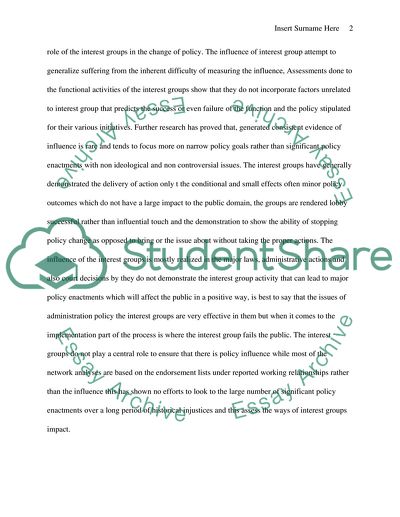Cite this document
(Networks of Working Relationships or Coalitions: Policy Change Literature review, n.d.)
Networks of Working Relationships or Coalitions: Policy Change Literature review. Retrieved from https://studentshare.org/politics/1789939-answer-the-2-q-by-using-these-2-books-berry-jeffery-wilcox-clyde-the-interest-group-society-5th-edition-new-york-pearson-longman-and-write-john-interests-groups-and-the-congress-lobbying-contributions-and-influence
Networks of Working Relationships or Coalitions: Policy Change Literature review. Retrieved from https://studentshare.org/politics/1789939-answer-the-2-q-by-using-these-2-books-berry-jeffery-wilcox-clyde-the-interest-group-society-5th-edition-new-york-pearson-longman-and-write-john-interests-groups-and-the-congress-lobbying-contributions-and-influence
(Networks of Working Relationships or Coalitions: Policy Change Literature Review)
Networks of Working Relationships or Coalitions: Policy Change Literature Review. https://studentshare.org/politics/1789939-answer-the-2-q-by-using-these-2-books-berry-jeffery-wilcox-clyde-the-interest-group-society-5th-edition-new-york-pearson-longman-and-write-john-interests-groups-and-the-congress-lobbying-contributions-and-influence.
Networks of Working Relationships or Coalitions: Policy Change Literature Review. https://studentshare.org/politics/1789939-answer-the-2-q-by-using-these-2-books-berry-jeffery-wilcox-clyde-the-interest-group-society-5th-edition-new-york-pearson-longman-and-write-john-interests-groups-and-the-congress-lobbying-contributions-and-influence.
“Networks of Working Relationships or Coalitions: Policy Change Literature Review”, n.d. https://studentshare.org/politics/1789939-answer-the-2-q-by-using-these-2-books-berry-jeffery-wilcox-clyde-the-interest-group-society-5th-edition-new-york-pearson-longman-and-write-john-interests-groups-and-the-congress-lobbying-contributions-and-influence.


